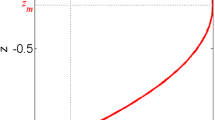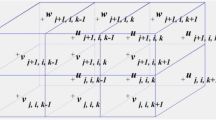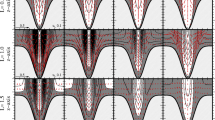Abstract
We showed that, in all of the previous studies made of the horizontal circular “Tide-induced residual current (TIRC)”, the velocity field was far beyond the application limit of the TIRC theory and the discussions in previous studies had no physical reality, because in the circular TIRC, the pressure gradient force balances with the centrifugal force and a weak Coriolis' force. We also showed that the Euler numberAP, which is defined by the ratio of the advection term to the pressure gradient term, is useful as a measure of nonlinearity of the temporal tidal velocity field in a numerical model experiment, and that the measureAP must be less than 0.05 or at least less than 0.1 for us to discuss the TIRC as a physical entity of “steady current” in physical space. We proposed another measure,KE, which is defined as the ratio of the sum of kinetic energies of compound- and over-tides to kinetic energies of diurnal- and semi-diurnal tides. We showed that this measure,KE, is also useful as an indicator of the magnitude of nonlinearity of tidal velocity field. We presented the distribution ofKE in the Seto Inland Sea of Japan, showing that the nonlinearity is very large in many places of the basin, which must be considered when analyzing tidal current velocities and the dynamics of the current system or material transport in the Seto Inland Sea.
Similar content being viewed by others
References
Awaji, T., N. Imasato and H. Kunishi (1980): Tidal exchange through a strait—A numerical experiment using a simple model basin. J. Phys. Oceanogr.,10, 1499–1508.
Cheng, R.T. and V. Casulli (1982): On Lagrangian residual curren with applications in South San Francisco Bay, California. Water Resour. Res.,18, 1652–1662.
Feng, S., R.T. Cheng and P. Xi (1986a): On tideinduced Lagrangian residual current and residual transport, 1. Lagrangian residual current. Water Resources Res.,22, 1623–1634.
Feng, S., R.T. Cheng and P. Xi (1986b): On tideinduced Lagrangian residual current and residual transport, 2. Residual transport with application in South San Francisco Bay, California. Water Resources Res.,22, 1635–1646.
Imasato, N., T. Awaji and H. Kunishi (1980): Tidal exchange through Naruto, Akashi and Kitan Straits. J. Oceanogr. Soc. Japan,36, 151–162.
Imasato, N. (1983): What is the tidally-induced residual current? J. Phys. Oceanogr.,13, 1307–1317.
Kashiwai, M. (1984a): Tidal residual circulation produced by a tidal vortex. Part. I. Life-history of a tidal vortex. J. Oceanogr. Soc. Japan.,40, 279–294.
Kashiwai, M. (1984b): Tidal residual circulation produced by a tidal vortex. Part II. Vorticity balance and kinetic energy. J. Oceanogr. Soc. Japan.,40, 437–444.
Kreeke, J.V.D. and S.S. Chiu (1980): Tide-induced residual flow. 133–144.In: Mathematical Modelling of Estuarine Physics, ed. by J. Sundermann and K.P. Holz, Springer-Verlag, pp. 263.
Oonishi, Y. (1977): A numerical study on the tidal residual flow. J. Oceanogr. Soc. Japan,33, 207–218.
Oonishi, Y. (1978): A numerical study on the tidal residual flow—Vertical motion induced by tidal current. J. Oceanogr. Soc. Japan.,34, 140–159.
Pingree, R.D. and L. Maddock (1977): Tidal residuals in the English Channel. J. Mar. Biol. Assn. of U.K.,57, 339–357.
Sugimoto, T. (1975): Effect of boundary geometries on tidal currents and tidal mixing. J. Oceanogr. Soc. Japan.,31, 1–14.
Tee, K.T. (1976): Tide-induced residual current, a-2D nonlinear numerical tidal model. J. Mar. Res.,34, 603–628.
Yanagi, T. (1976): Fundamental study on the tidal residual circulation I. J. Oceanogr. Soc. Japan.,32, 199–208.
Yanagi, T. (1978): Fundamental study on the tidal residual circulation II. J. Oceanogr. Soc. Japan.,34, 67–72.
Yanagi, T. (1980): Vertical residual flow in Kasado Bay. J. Oceanogr. Soc. Japan.,35, 168–172.
Yasuda, H. (1980): Generating mechanism of the tidal residual current due to the coastal boundary layer. J. Oceanogr. Soc. Japan.,35, 241–252.
Yasuda, H. and J.F.T. Zimmerman (1986): Tideinduced residual currents with Stokes and Ekman layers over undulatory sea floor. J. Oceanogr. Soc. Japan.,42, 276–293.
Zimmerman, J.F.T. (1978): Topographic generation residual circulation by oscillatory current. Geophys. Astrophys. Fluid Dynam,11, 35–47.
Author information
Authors and Affiliations
Rights and permissions
About this article
Cite this article
Imasato, N. Application limit of Tide-induced residual current theory. Journal of the Oceanographical Society of Japan 43, 319–331 (1987). https://doi.org/10.1007/BF02108699
Received:
Accepted:
Issue Date:
DOI: https://doi.org/10.1007/BF02108699




